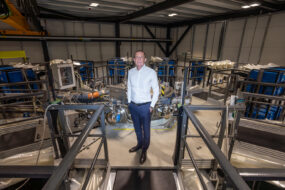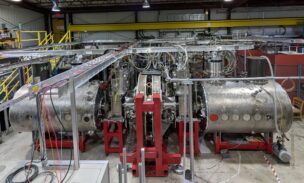A thriving nuclear energy industry, at least as it’s imagined and being built today, will rely on plentiful uranium. But uranium supply is limited, and those who mine it are trying to scale up their output in anticipation of a boom in demand.
Duane Parnham has been building and scaling mining companies for several decades, and now, he’s turned his focus to uranium extraction through Madison Metals. Parnham believes that the opportunity is ripe, and is reading the signs of increasing uranium demand and prices to prepare for the next generation of nuclear customers.
In this interview with Ignition, Parnham dives into the details of what makes uranium mining such a lucrative prospect right now.
This interview has been edited for length and clarity.
Ignition: You’ve started a good handful of metals and resource focused companies over the years. What do you think the opportunity right now is in mining and resource extraction?
Parnham: Mining itself is pretty cyclical. It’s one of those industries that is not well liked by mainstream financial markets just because of its complexity and its uncertainties, but unfortunately, the metals that we extract are so necessary on almost every facet of life, and it’s generally overlooked and under-financed…at a time when the metal is most needed. So it creates supply gaps and, you know, hits and misses.
Who bears the responsibility for making sure that uranium mining projects have sustained financing?
It would be in the management. The different projects have different financial capabilities, qualities. Each asset globally has different characteristics; again, jurisdiction, size of the deposit, grade of the deposit location, infrastructure, all these types of external factors influence whether a particular deposit will be economic and be financed and put into production.
And then you’ve got the overlying commodity price. If the commodity prices are strong, that interest grows, institutional investors get excited about that particular commodity. Right now, it seems to be uranium, because uranium was $30 early last year. It’s up almost 88% this year, probably 100% year to date. And you’re looking at a strong forecast for even further pricing into the future. So right now, the emphasis is on uranium, and I think for the right reason. The underlying fundamentals are looking very strong, and certainly stronger than what I saw in 2007.
How much does public opinion on nuclear energy production impact the real financials and market for uranium?
Huge, huge, because nuclear energy has always been sort of that mystery, you know, bad way of producing electricity. However, it’s the most sustainable, cheaper, and has zero carbon footprint, and it’s the only baseload electrical supply to meet the growing gap as we move to electrical vehicles and all these other things with normal growth. These green energy initiatives that have been implemented by politicians hadn’t really thought about the real baseload supply needs to fill these gaps. So uranium and nuclear energy are playing a significant role today, more so than in the past.
Public opinion now is growing in favor of nuclear energy because of certain things, like France calls nuclear green, you’ve got environmentalists now accepting nuclear as a favorable energy source, you’ve got big-name politicians, you’ve got big-name personalities that are supporting it. But you can’t discount the underlying fundamentals of nuclear energy on what it can deliver for the costs. And it’s a very safe industry, and it provides the necessary energy that the world needs on a day to day basis. So that’s really the only choice.
This is a global shift in supporting nuclear energy. So you’ve got all of those energy needs, but the problem is they forgot about the miners, because the miners are the ones that are providing the raw material to feed the reactors. And we haven’t spent enough time and energy and money helping guys like us to go find new mines and new sources of yellowcake to feed these reactors. So I think it’s gonna be an interesting next few years for us. It’s going to be a lot of money being thrown at a lot of companies, and we’ll see which ones survive to deliver the necessary product.
Madison Metals focuses on sustainable uranium production in Namibia and Canada. So what does sustainable uranium production look like?
Our idea is a fast track to production. Sustainable, meaning that we don’t have to finance huge amounts of infrastructure—because it’s there already, we can utilize the existing infrastructure. And we can get these products to the market faster than many, many other jurisdictions. And when you look at Namibia, it’s probably the third largest uranium producer. It’s been sustainable since 1976. There’s three operating uranium mines in Namibia today. Two are owned by the Chinese government and one is owned by an Australian group, and then there’s licensed deposits like the one that we’ve developed at Forsys Metals, and then there’s a couple others that are licensed for Australian groups.So Namibia provides an amazing opportunity for supplying a sustainable amount of uranium to meet this growing demand during these high uranium prices.
Tell me a little bit about this announcement that you discovered high-grade uranium mineralization at the Namibia site. How much does uranium quality at mining impact how it can be utilized in the future?
When you’re looking at any commodity and evaluating its value or its chance of being successful, we always look at grade, because grade provides a lot of material for a very small amount of rocks. Namibia is always known for its lower grade uranium deposits. We’re able to do that because these are opencast mines. So you’re basically a big rock moving, crushing, pulverizing, using acid leach distillation to get the yellowcake out. So we’re able to mine these lower grade deposits in this terrain because it’s easily accessible and now the infrastructure is there.
The significance of finding high-grade in Namibia—8.5% in one trench, and that’s not going to be the average grade, don’t get me wrong. However, when you see something of that grade, it’s really unique for this environment. That’s a huge, significant upgrade in the grade and the quality of that material. We can open pit it, and we can truck it to the existing infrastructure. So low costs, that’s on a mining license, upgrading that won’t take much effort and time, and then you’ve got the quality of the rock that will give us a huge return when we eventually mine it.
What kind of processing is needed to go from that raw material to something that can actually be utilized for nuclear operations?
Basically what will happen from the mine is you would crush the rock, you would grind it down to a size whereby you can pass a dissident acid dissolution, and then they would draw out the uranium from the acid and dry it so it becomes a powder that they can put in drums. So mining is very, very simple in Namibia. Then what they do is they take those drums of uranium-308 and they send them to a conversion facility, and they would upgrade the uranium using a process to make it a higher-grade concentrate. Then they would put it into pellets and then load the rods for a nuclear reactor. So from the mining side, it still has to go to a conversion facility. And there’s only a few of those in the world.
On the backdrop of all that, then the end users, the utilities, have experienced a pretty simple last 20 or 30 years of just being able to buy uranium from the traders…and they can easily get supplied for two years, three years. The problem now is that with all the growth, we’re really extending nuclear facility reactor life. All of the growth has put a real pressure on raw material availability. There’s probably good supply for these utilities in years one to five, maybe, but it’s five years out that is really creating a problem, because now they’re thinking longer term in their supply needs whereas in the past they were able to access supply at a pretty cheap price and pretty readily available. So this is creating more of a thought of higher uranium prices down the road.
Is there a way to alleviate that concern for the nuclear industry?
There’s a huge shortage of raw material coming in ~2040. It’s massive, because right now we’re mining about 140 to 150M lbs and we consume 190M lbs already of uranium. So there’s already been like a 40-50M lb gap. And that gap has traditionally been supplied by stockpiling.
With all of the new demand coming in, there’s going to be a huge deficit of uranium in the next number of years. And it’s definitely going to put a lot of pressure on the Madison Metals of the world and the other miners to start producing their product a lot sooner.
What is the timeline for getting this new deposit discovered at the Namibia site to customers?
I think within 18 months is a realistic timeframe. And I say that because of the permitting. Usually for this type of operation, permitting is your longest lead time. I mean, we can go and drill, we can come up with an engineering plan very quickly. But permitting, generally, would be the longest time. Fortunately for us we’re sitting on a mining license already. The ground was already permitted for mining. They were mining copper. They didn’t look for uranium. That’s the benefit for us now, finding new uranium deposits on a mining license that was mined for other commodities.
Sounds like you lucked out there.
Well, I’ve been working there 22 years so yeah, what do they say? A blind squirrel finds a nut every once in a while, right.
What do you think the biggest misconception about nuclear power generation is?
Safety. I think that when you look at the history of nuclear generation, there’s only been three instances where we’ve had an issue. One was man—Chernobyl was man—and then the other two were natural. I think that in today’s world, with technology, and with safety measures and a regulatory environment, I think nuclear reactors are far safer than anything else that we have out there.
What are the new businesses, use cases, or products you see being opened up in nuclear energy in the next five to 10 years?
I think the conversion facilities. I think we need more of them, because obviously, we’re going to be using a lot more Uranium-308 that needs to be converted to feed these reactors. I think that’s gonna be an interesting sector. I mean, the mining side is so boring. We can kind of do it in our sleep, we’ve got to do the financing and have an end product user, and our side’s pretty straightforward. I think there’s going to be a lot of technical advancement in nuclear energy generation, in coming up with new solutions to power generation using nuclear. Mini reactors, those types of things. I think that’s going to be the exciting part.
What new regulation or dropping of an old regulation would help your business the most if it were passed today?
Just the permitting, just getting government support. It is fairly complex when you’re talking about nuclear, with health and safety and public opinions and all that stuff. So I just think make it a little bit easier for selecting sites and getting permits for building these reactors.
What’s the best piece of advice you’ve gotten in your career?
Don’t be afraid of innovation. And follow what you believe, use your instincts. And don’t allow people to derail your ambition to deliver a product. I think that’s probably the biggest one. I mean, there’s tons, but just do what you believe in and don’t lose sight of that.
Lead Reporter of Ignition





